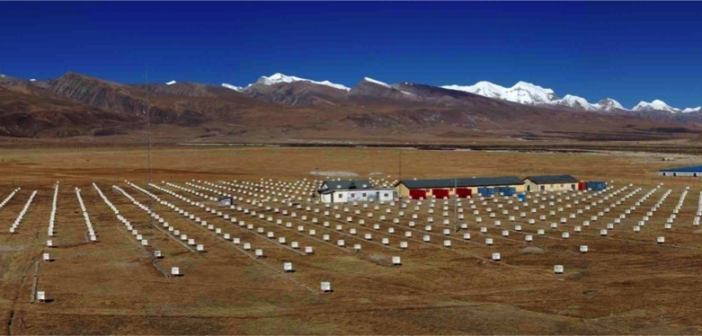Editor’s note: Astrobites is a graduate-student-run organization that digests astrophysical literature for undergraduate students. As part of the partnership between the AAS and astrobites, we repost astrobites content here at AAS Nova once a week. We hope you enjoy this post from astrobites; the original can be viewed at astrobites.org!
Title: Northern sky Galactic Cosmic Ray anisotropy between 10-1000 TeV with the Tibet Air Shower Array
Authors: The Tibet AS Collaboration
First Author’s Institution: Yale University
Status: Accepted to ApJ, open access
One of the big unsolved mysteries in particle astrophysics is the origin and acceleration mechanisms of cosmic rays, or charged particles that are constantly bombarding the Earth. It is impossible to tell which astronomical source is the origin of any one particular cosmic ray. Because cosmic rays are charged particles, they are deflected on their way to Earth by our galactic magnetic field. Due to this effect, one might expect cosmic rays to arrive isotropically (in equal numbers in every direction), with slight anisotropy because of diffusion effects. However, that is not what is observed. Instead, there is a large-scale anisotropy with an energy-dependent amplitude. This causes problems for traditional diffusion models. Studying this anisotropy is important in learning more about cosmic rays.
Today’s bite uses roughly five years of data from the Tibet Air Shower experiment, located at 4300 meters above sea level in Tibet, to provide an update in the study of the cosmic-ray anisotropy. The area of the sky they looked at is slightly larger than in their previous papers, and when combined with data from the IceCube experiment in Antarctica, allows us to have a complete picture of the entire sky in the energy range of a few hundred TeV.
New Results

Left: The anisotropy, as seen in 5 different energy bins. From top to bottom, the median energy is 15, 50, 100, 300 and 1000 TeV. Right: The 1D projection of the plot on the left. The blue curve is the first harmonic fit to the data. Note how the phase changes with energy. [Amenomori et al. 2017]
- In the map corresponding to a median energy of ~300 TeV, there are two regions that can be seen by eye: one area where there is an excess of cosmic rays, and another area where there is a deficit. Only the excess is statistically significant after taking trials into account. (For a description of what “trials” are in a statistical context, check out this page about the “look-elsewhere effect“). This result is consistent with what IceCube sees in a similar energy range. The authors looked to see if this anisotropy is due to the Compton-Getting effect (i.e. if it was caused by the motion of our solar system around the center of our Galaxy). The Compton-Getting effect predicts that we would see more cosmic rays coming from the direction that the Earth is moving toward, with a deficit coming from the other direction. They concluded that this particular excess is not related to the Compton-Getting effect.
- The anisotropy appears to be energy dependent. The maps in the 15–50 TeV range have completely different features than the maps at a few hundred TeV/1 PeV. (See the figure above for an illustration)
- These effects are not related to seasonal variations in the performance of the detector (atmospheric effects can affect experiments such as the Tibet Air Shower array, but it was shown to be negligible in this case).
So what are the implications of this? Well, for one, studies like these give us some hints as to the origins of cosmic rays. For example, at a few hundred TeV, the most significant excess is coming from the direction of the Galactic center. However, the observed energy dependence shows that there is still a lot to learn about how cosmic rays diffuse. Changes in the anisotropy with energy may imply that the cosmic ray propagation parameters are evolving.
About the author, Kelly Malone:
I am a fourth year physics graduate student at Penn State University studying gamma-ray astrophysics. I previously received bachelor’s degrees in physics and astronomy from UMass Amherst in 2013.
